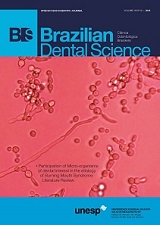Mechanical behavior of NiCr and NiCrTi alloys for implant prosthetic components
DOI:
https://doi.org/10.14295/bds.2013.v16i2.863Resumo
Purpose: The aim of this study was to evaluate the tensile and hardness mechanical properties, as well as the composition and microstructure of three different alloys used for implant prosthestic components casting. Methods: The alloys were divided into three groups: Tilite (Tilite), Vera (Verabond) and Malloy (DanCeramalloy). For the tensile test, the specimens (n=10) of each group were evaluated in “alter” form and the maximum load fracture, the deformation at maximum load and Young´s modulus were determined. The data was subjected to one way ANOVA and Turkey’s test. For the hardness test, five discs from each group were evaluated for Vickers hardness. The data was analyzed using multiple regression ANOVA followed by the Turkey’s test. The significance level was set at 5% (? = 0.05). The composition and microstructure was determined through analysis of two specimens from each group by metallographic analysis (MEV/EED). Results: With regards to maximum load tensile, the deformation and the Young´s Modulus the three alloys evaluated were statistically similar. Regarding hardness, Tilite showed significant higher values than the others alloys. Conclusion: All the examined alloys can be used in implant prosthetic components and the presence of the element Ti did not influence the mechanical behavior of the alloy.Downloads
Downloads
Arquivos adicionais
Publicado
Como Citar
Edição
Seção
Licença
TRANSFERÊNCIA DE DIREITOS AUTORAIS E DECLARAÇÃO DE RESPONSABILIDADE
Toda a propriedade de direitos autorais do artigo "____________________________________________________________________" é transferido do autor(es) para a CIÊNCIA ODONTOLÓGICA BRASILEIRA, no caso do trabalho ser publicado. O artigo não foi publicado em outro lugar e não foi submetido simultaneamente para publicação em outra revista.
Vimos por meio deste, atestar que trabalho é original e não apresenta dados manipulados, fraude ou plágio. Fizemos contribuição científica significativa para o estudo e estamos cientes dos dados apresentados e de acordo com a versão final do artigo. Assumimos total responsabilidade pelos aspectos éticos do estudo.
Este texto deve ser impresso e assinado por todos os autores. A versão digitalizada deverá ser apresentada como arquivo suplementar durante o processo de submissão.




























